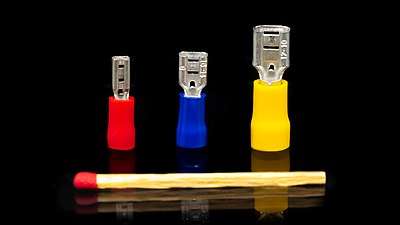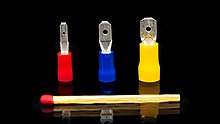FASTON terminal
FASTON terminals are connectors that are widely used in electronic and electrical equipment. These terminals are manufactured by many companies, commonly using the term "quick disconnect", "tab" terminals, or blade connectors. They are similar in size to some of the Packard terminals, such as Packard 56, and may have been derived from them.


The terminals are often called "quick disconnect", because the predecessors were screw terminals. It took more time to unscrew these terminals to disconnect a wire. The name "tab" terminals is a description of the shape of the male terminal.
Six series are available, named after their width in inches.[1] Insulated versions of the terminals are color-coded to indicate what wire gauges they may be used with. The terminal system consists of tabs (male) and receptacles (female). There are free-hanging wire and circuit board mounted versions of both tabs and receptacles.
A little-known hand tool exists for inserting the terminals, the AMP Universal Handle.
They have been commonly used since the 1970s. Faston is a trademark.
Specifications
- PIDG FASTON (Nylon) terminals are defined in AMP Specification 114-1002: Terminal, FASTON, PIDG, Application of
- PLASTI-GRIP (Vinyl) (insulation restricting) terminals are defined in AMP Specification 114-1003: Terminal, FASTON, PLASTI-GRIP, Application of
- UL 310 "Standard for Electrical Quick--Connect Terminals"[2]
- CSA 22.2 #153, “Quick--Connect Terminals”
- UL 486 also specifies the testing of standard wire connectors and soldering lugs.
- MIL-T-7928
Crimp styles
Four main styles of crimps are specified by AMP:
- "F" Crimp for use on non-insulated connectors
- TETRA-CRIMP for use on insulated PIDG and PLASTI-GRIP connectors
- "C" Crimp - typically used for flag connectors (where the wire enters the connector perpendicular to the direction of tab insertion)
- Tab-Lok - typically used for flag connectors
Wire gauge insulation colors
The colors don't provide information about the polarity of the crimped cables but specify their diameter.
| Insulation color code | AWG size range | Comments |
|---|---|---|
| Yellow | 26–22 | |
| Transparent | 24–20 | |
| Red | 22–16 | |
| Blue | 16–14 | |
| Yellow/Black | 16–14 | Heavy Duty |
| Yellow | 12–10 | |
| Red | 8 | |
| Blue | 6 | |
| Yellow | 4 | |
| Brown | 2 | |
| Blue | 1/0 | |
| Yellow | 2/0 | |
| Red | 3/0 | |
| Blue | 4/0 |
312 series
0.312-inch (7.92 mm) male tab width
250 series
0.250-inch (6.35 mm) male tab width
- 10 AWG, 24 amps (continuous)
- 12 AWG, 20 amps (continuous)
- 14 AWG, 15 amps (continuous)
- 16 AWG, 10 amps (continuous)
- 18 AWG, 7 amps (continuous)
- 20 AWG, 4 amps (continuous)
- 22 AWG, 3 amps (continuous)
205 series
0.205-inch (5.21 mm) male tab width
- 14 AWG, 15 amps (continuous)
- 16 AWG, 10 amps (continuous)
- 18 AWG, 7 amps (continuous)
- 20 AWG, 4 amps (continuous)
- 22 AWG, 3 amps (continuous)
187 series
0.187-inch (4.75 mm) male tab width
- 16 AWG, 10 amps (continuous)
- 18 AWG, 7 amps (continuous)
- 20 AWG, 4 amps (continuous)
- 22 AWG, 3 amps (continuous)
125 series
0.125-inch (3.18 mm) male tab width
110 series
0.110-inch (2.79 mm) male tab width
- 16 AWG, 5 amps (continuous)
- 18 AWG, 4 amps (continuous)
- 20 AWG, 3 amps (continuous)
- 22 AWG, 2 amps (continuous)
See also
- Lucar connector
References
- "FASTON Terminals Insulated and Uninsulated" (PDF). Retrieved 11 July 2015.
- "UL 310 Electrical Quick-Connect Terminals". Retrieved 11 July 2015.
External links
- te.com FASTON, PIDG, AMP and PLASTI-GRIP are trademarks.
- Stocko-Contact.com